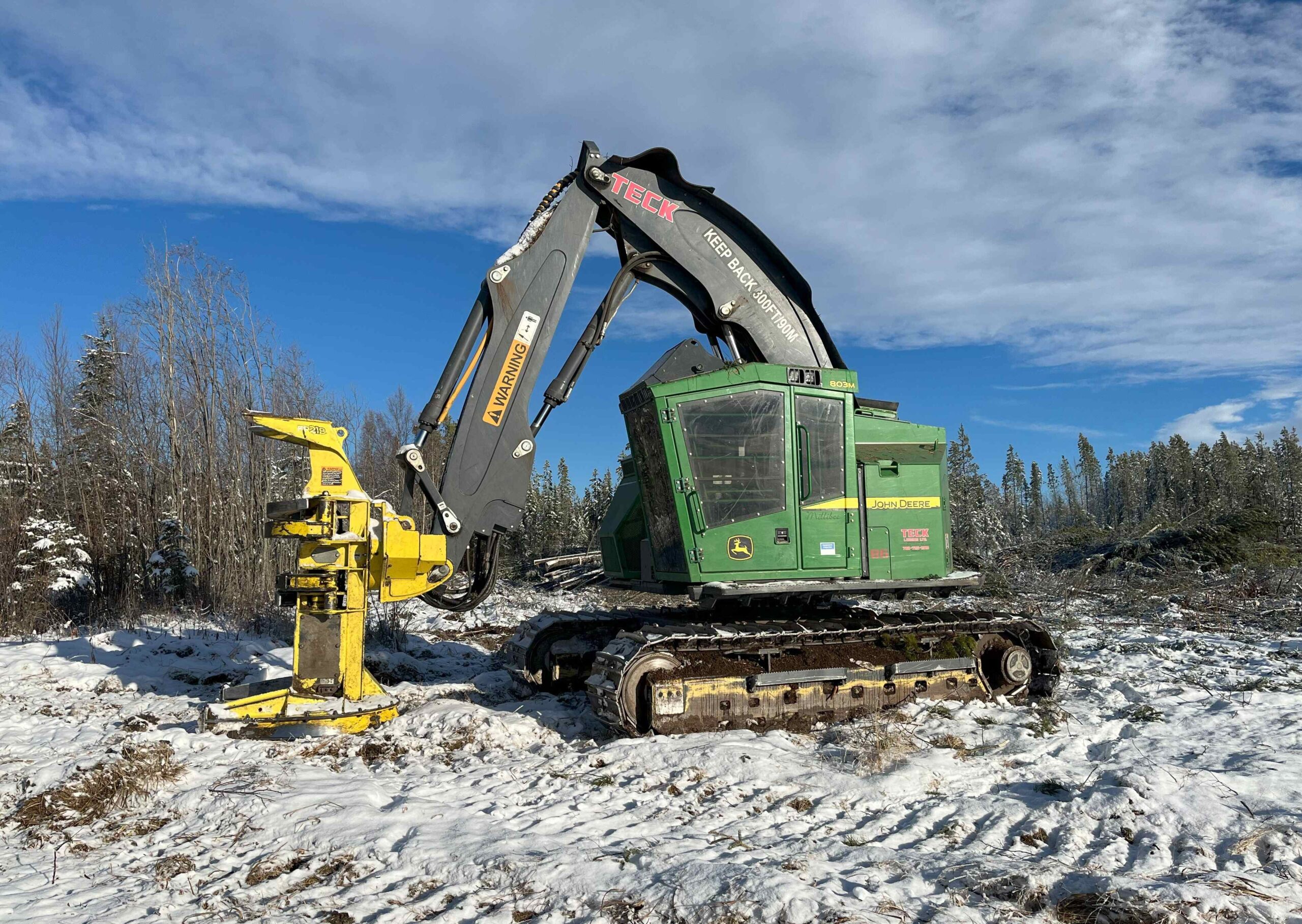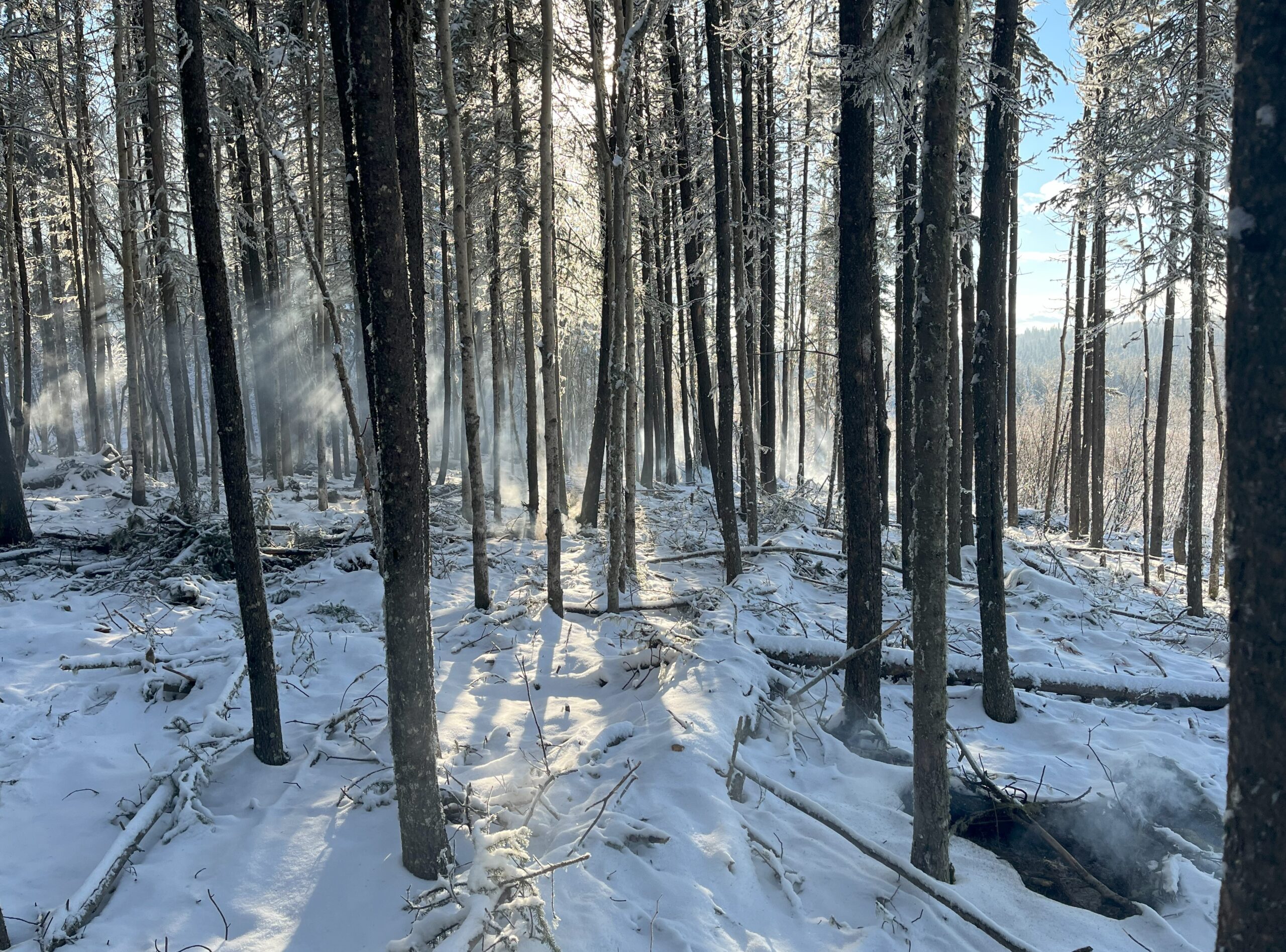Fort Nelson, B.C. – In a bid to safeguard their community from the escalating threat of wildfires, British Columbia’s largest community forest is proactively undertaking wildfire risk reduction work with support from Forest Enhancement Society of BC (FESBC) funding. The Fort Nelson Community Forest Fuel Treatment Project, set against the backdrop of remote wilderness, is a testament to the power of collaboration and determination and represents a remarkable opportunity for growth, local capacity building, and economic empowerment.
In a collaborative move, the Fort Nelson Community Forest (FNCF) was formed when the largest community forest license in the province was awarded to the Fort Nelson First Nation (FNFN) and Northern Rockies Regional Municipality (NRRM) partnership. The partnership between the FNFN and NRRM represents not only the largest community forest license in British Columbia but also yields the most substantial harvestable volume. Considering the remote and expansiveness of the area covered by the license, this means there is a tremendous responsibility for the FNCF, one which they are prepared to undertake.
Photo credits: Fort Nelson Community Forest.
“The Fort Nelson Community Forest, like others throughout B.C., supports long-term opportunities and contributes to a more diversified forest economy,” said Bruce Ralston, Minister of Forests. “As the keepers of B.C.’s biggest community forest, it’s great to see the Northern Rockies Regional Municipality and the Fort Nelson First Nation collaborate on this project to better protect their homes, schools, businesses and the surrounding forests that are the lifeblood of their remote communities.”
The FESBC-funded FNCF Fuel Treatment Project is set to address a 20-hectare expanse of forest, roughly the size of 37 football fields, along the southwest side of the Alaska Highway. By creating a shaded fuel break using mechanical treatments, which means clearing and reducing the growth of plants and trees in the area using machines or equipment, the project aims to slow wildfire spread, enhance suppression efforts and firefighter safety, reduce the risk of a wildfire spreading up into the crown or tops of trees, and maintain vital evacuation routes for public safety, such as Highway 97.
Acknowledging the importance of funding and support, the FNCF highlighted the significance of FESBC funding to help develop their capacity, particularly as they continue to establish themselves.
Katherine Wolfenden, the board chair of the FNFC, said, “Our community forest partnership is excited to have been selected for funding from FESBC. This project will help the local community have more control over where and how firebreaks and selective reduction of high-risk areas occur next to the community. As a new and developing community forest, this project is helping us implement one of our guiding management goals to support and invest in community wildfire prevention initiatives.”
Echoing Wolfenden’s statement, Ben Wall, the general manager of the FNCF, also noted the importance of FESBC funding.
“Adequate funding and support are essential to the success of the community forest. Funding is required to continue the research, planning, and monitoring of the forest, the use of qualified and experienced professionals as well as continuing to promote local engagement. The FESBC funding is of the utmost importance for this project as it will help us develop capacity. With the Fort Nelson Community Forest still working on getting firmly established and viable, help with funding like this is critical,” said Wall.
This project, however, means so much more to the community and the forest than simply reducing wildfire risk. The collaboration between the Northern Rockies Regional Municipality, Fort Nelson First Nation, and other stakeholders will promote forest sustainability through wildlife habitat preservation, timber harvesting, wildfire mitigation efforts, and recreational opportunities.
FESBC Senior Manager Gord Pratt said, “FESBC is excited to be able to support the Fort Nelson Community Forest early in their existence on such an important project reducing the local wildfire risk to the community, improving wildlife habitat and building local capacity in the forest sector.”
According to Matt Pilszek, RFT, Forestry and Construction Manager with Geoterra, the fuel mitigation project will have wildlife enhancement objectives in mind throughout the treatment, with a specific focus on protecting and enhancing the Boreal caribou ungulate winter range. The fuel mitigation treatment will reduce the accumulation of flammable vegetation and deadwood, which helps reduce the risk of large, destructive wildfires detrimental to wildlife habitat. Preserving the winter range from being impacted by wildfires ensures that caribou and other ungulates have access to the habitat they need during the critical winter months.
“Fuel mitigation through selective thinning of trees can help preserve and restore the natural vegetation and forest structure within the Boreal caribou ungulate winter range. This is important because these animals rely on specific types of vegetation for food and shelter during the winter. Selective thinning techniques can promote the growth of new vegetation in the understory (the layer of vegetation that grows beneath the forest canopy, consisting of smaller plants, shrubs, and young trees) while maintaining habitat connectivity within the landscape,” said Pilszek.
The fuel mitigation project will also support the Fort Nelson community by building local capacity and contributing to the region’s economy through job creation, community involvement, revenue generation, increased resilience to wildfires, and sustainable resource management. The fuel mitigation project will utilize local businesses, including forestry contractors, equipment operators, local First Nations land guardians, and service providers, which will stimulate the local economy and provide more work to these contractors.
“The selective thinning process will provide sustainable forest management to ensure that local forest resources are managed in a way that provides economic benefits while preserving the environment for future generations in Fort Nelson,” said Wall. Prior to the commencement of the fuel mitigation project, the FNCF actively engaged with the local community. They hosted an open house and secured approval from the FNFN through the Land Management Framework, a plan for how to use and take care of the land.
According to Wall and Pilszek, as this project gets underway, the community forest is planning to host another open house to get feedback from the community to understand if there is a desire to expand this type of treatment to other areas around the community.
“Often, the main concern about a project like this is there can be resistance and disagreement with what is being implemented and how it is being done. However, the community forest has engaged with all stakeholders within and around the project in a way that avoids interruptions. The snowmobile club, for example, has been very supportive and flexible in our discussions, and we have worked on a plan to mitigate any impact we might have on their activities. We intend to improve trail access in whatever way we can as we continue to work on this project and others in the future,” added Wall.
The FNCF is working with the local forest industry to grow the forest industry in Fort Nelson. As harvesting activity increases, the FNCF will be better positioned to self-fund projects. For example, the community forest harvested a significant amount of wood in 2021, approximately 30,000 cubic metres of wood, which is roughly equivalent to filling 20 Olympic-sized swimming pools. They anticipate harvesting approximately 23,000 cubic metres during the 2023 winter harvest.
In addition to harvesting, the community forest is focused on a comprehensive and holistic land management plan and is working toward reforestation in identified areas.
“Last year, Geoterra supervised the Fort Nelson Community Forest Tree Planting Program, exceeding minimum quality standards by planting 226,440 trees. Planting densities adhered to wildfire guidelines, with 1,600 stems, or trees, per hectare outside the Wildland Urban Interface (a zone where human development and natural landscapes come into contact) and 800 stems per hectare within the Wildland Urban Interface,” said Pilszek.
The community forest recognizes a need to build capacity significantly to maximize the forest value to the partner communities. They are currently developing projects that have a higher percentage of merchantable timber that can be used to offset the costs of the work, and the hope is to be able to self-fund forest management activities from the sale of the lumber and wood fibre to a small local manufacturing entity in the future.
FESBC would like to gratefully acknowledge the financial support of the Province of British Columbia through the Ministry of Forests.


